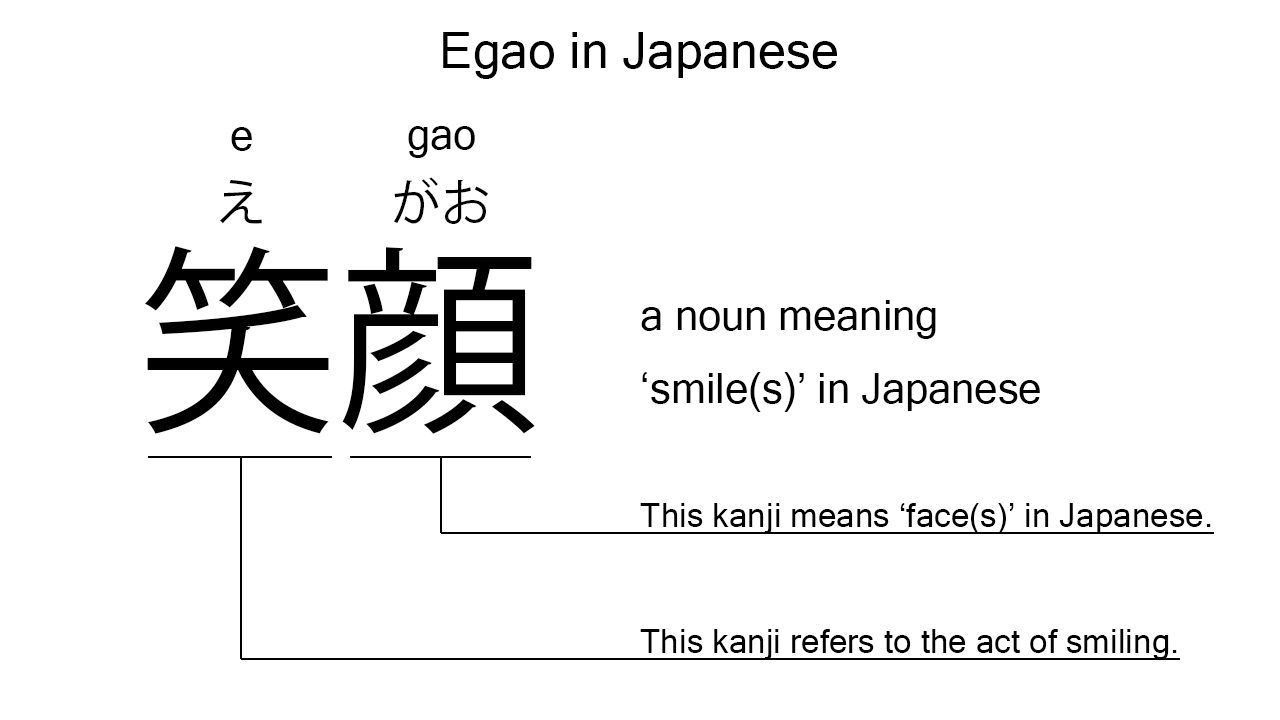What does “egao” mean in Japanese?
Native speakers say “egao” often to mean ‘smile’ in Japanese. Perhaps, some Japanese learners know this word as it is sometimes used in Japanese movies, songs, novels, manga, anime, and the like. In this blog post, however, I will explain this word in detail based on its kanji expression. And also, I will explain how to use it through example sentences. My explanations would help Japanese learners understand “egao” more clearly. Then, let’s get started!
Contents
Definition and meanings of “egao”
Let me start with the definition and meanings of “egao”.
- egao – 笑顔 (えがお) : a noun meaning ‘smile’ or ‘smiling face’ in Japanese. This can also work as plural. Learn more about Japanese plural.
The definition and meanings are simple and clear. To understand this noun more clearly, however, let me explain its kanji characters in detail, one by one.
What does “egao” literally mean in Japanese?
The kanji expression of “egao” consists of the following two kanji characters:
- 笑 : a kanji character used to refer to the act of smiling or laughing. This kanji can also be found in other words like “warau“.
- 顔 : a kanji character used to mean ‘face’ in Japanese.
These two kanji characters tell us that “egao” literally means a ‘smiling face’ in Japanese. This literal interpretation is completely in line with the actual meanings.

When we meet new kanji expressions, we should check their kanji characters in detail to understand their meanings clearly and deeply. In many cases, kanji characters tell us a lot about the meanings of the expressions they form. Actually, here, we could get the better understanding of “egao” through the detailed kanji check above.
So far, I’ve explained the definition and meanings of “egao” together with its kanji characters. Then, let me explain how to use it through the example sentences below.
Example #1: how to say “smile” in Japanese
watashi wa kanojo no egao ga suki desu – 私は彼女の笑顔が好きです (わたしはかのじょのえがおがすきです)
I like her smile.
Below are the new words used in the example sentence.
- watashi – 私 (わたし) : a pronoun meaning ‘I’ in Japanese.
- wa – は : a binding particle working as a case marker or topic marker. In the example, this works after “watashi” to make the subject in the sentence.
- kanojo – 彼女 (かのじょ) : a pronoun meaning ‘she’ in Japanese.
- no – の : a case particle used after a noun or pronoun to make its possessive case. In the example, this is used after “kanojo” to make its possessive case, “kanojo no”, which means ‘her’ in Japanese.
- ga – が : a case particle used to make the subject word or the object word in a sentence. In the example, this is used after “kanojo no egao” to make the object in the sentence.
- suki – 好き (すき) : the stem part of the na-adjective, “sukina”, which means ‘favorite’ in Japanese. Native speakers, however, often use this as an individual word to mean ‘to like’ or ‘to love’ in Japanese. In the example, this is used to mean ‘to like’.
- desu – です : an auxiliary verb used after a noun or adjective to make it polite. Probably, this is well known as a part of Japanese desu form. In the example, this is used after “suki” to make it sound polite.
This is a typical usage of “egao”. In this example, it works as a part of the noun phrase, “kanojo no egao”, which means ‘her smile’ in Japanese. When we want to say “smile” in Japanese, this noun is a very good option.
Example #2: another usage of “egao”
kare no egao ga kie ta – 彼の笑顔が消えた (かれのえがおがきえた)
His smile was gone.
Below are the new words used in the example sentence.
- kare – 彼 (かれ) : a pronoun meaning ‘he’ in Japanese.
- kie – 消え (きえ) : one conjugation of the verb, “kieru”, which means ‘to vanish’, ‘to disappear’, or such in Japanese. In the example, it has been conjugated for the better connection with its following word.
- ta – た : an auxiliary verb used after a verb, adjective, or auxiliary verb to make its past tense form. Probably, this is well known as a part of Japanese ta form. In the example, this is used after “kie” to make its past tense form, “kie ta”, which literally means ‘to have disappeared’ in Japanese.
This is another typical usage of “egao”. In this example, it works as a part of the commonly-used phrase, “egao ga kie ta”, which literally means ‘a smile disappeared’ in Japanese. It has been translated into English as just ‘a smile was gone’, though.
Summary
In this blog post, I’ve explained the definition and meanings of “egao” in detail based on its kanji expression. And also, I’ve explained how to use it through the example sentences. Let me summarize them as follows.
- egao – 笑顔 (えがお) : a noun meaning ‘smile’ or ‘smiling face’ in Japanese. This can also work as plural. These two kanji characters literally mean a ‘smiling face’ in Japanese. This literal interpretation is completely in line with the actual meanings.
Hope my explanations are understandable and helpful for Japanese learners.